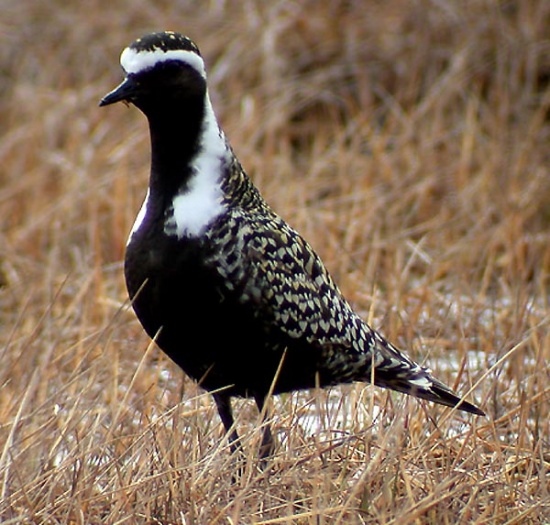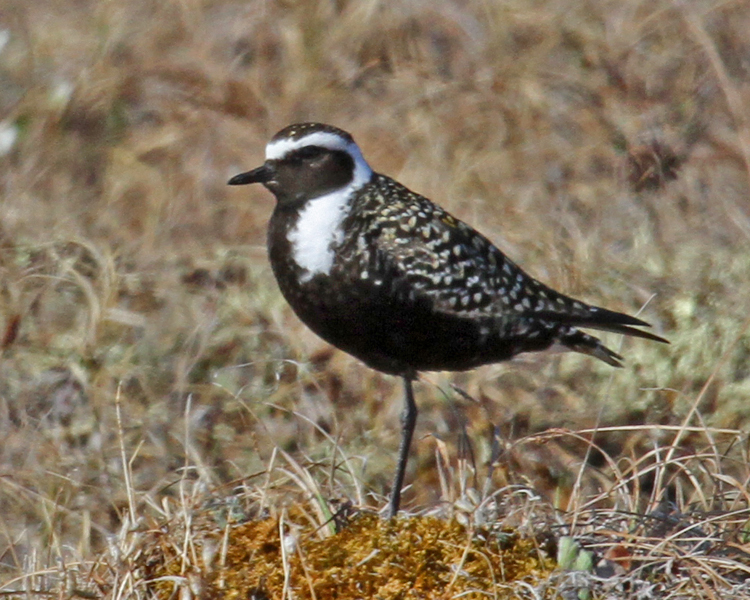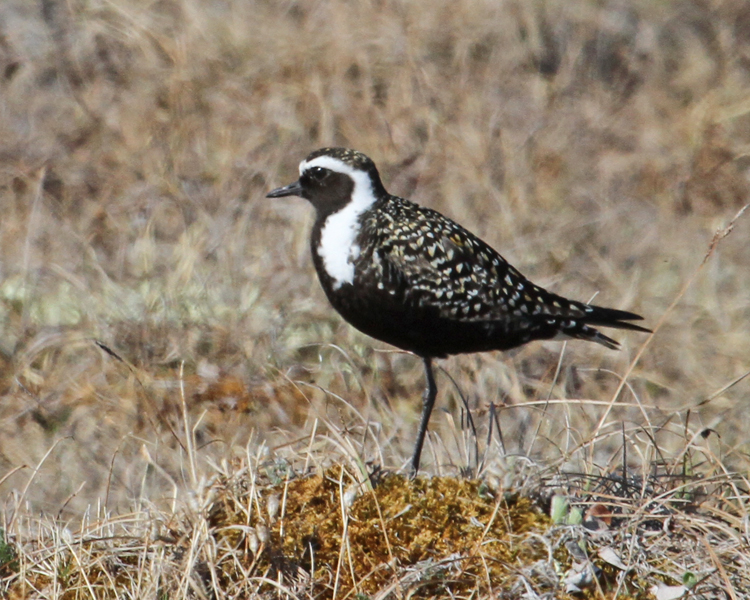
Pluvialis dominica
SUBFAMILY
Charadriinae
TAXONOMY
Pluvialis dominica P. L. S. Mьller, 1776. Monotypic.
OTHER COMMON NAMES
English: American lesser golden-plover; French: Pluvier dorй
d’ Amйrique, Pluvier bronzй; German: Sibirischer, Goldenregenpfeifer;
Spanish: Chorlito Dorado Americano.
PHYSICAL CHARACTERISTICS
9.5–11 in (24–28 cm); weight quite variable, ranging from
about 3.5 to 7 oz (99–198 g), with post-migration weights
much lower. During breeding season, upperparts are black;
yellowish edgings on the feathers of the upperparts give the
birds a golden-spangled appearance. The forehead and sides of
the neck are white. Face and underparts are black. In winter it
is speckled brown above with pale underparts.
DISTRIBUTION
Across Canada and Alaska in tundra habitats; possibly on
Chukoctskiy Peninsula, Wrangel Island, and Herald Island in
Russia. Winter in grasslands of South America south to northern
Argentina and Uruguay. May winter in Central America
and along the Atlantic and Gulf coasts of North America, with
most records from Florida. It is difficult to distinguish records
of migratory stragglers from winter residents. Rarely individuals
remain on the wintering grounds throughout the year.
Often found outside its normal range with reported occurrences
along western African coast, the Netherlands, Ireland,
Okinawa, New Guinea, and New Zealand.
HABITAT
Most common in the Arctic and sub-Arctic tundra and favors
rocky slopes with scattered low vegetation for breeding. A variegated
surface of rocks, gravel, lichen, and vegetation is preferred.
Moves young to wetter areas with more shrubs and
grasses for cover. During migration, found in a variety of open
habitats, including inland and coastal areas. Winter primarily
on grasslands of South America and less commonly on the
coastal wetlands. Agricultural lands are not used.
BEHAVIOR
Apparently migrate in small flocks, although large spring buildups
are known from northwest Indiana and northeast Illinois
with reports of more than 25,000 birds. Rapid fliers capable of
long-distance flights. Flight speed may exceed 112 mph (180
kph). Some individuals establish small winter territories. Nonterritorial
individuals maintain individual spacing through lowlevel
aggression. Wintering birds typically form communal
roosts. Occasionally gather in large flocks at freshwater wetlands
on wintering grounds to drink and bathe. Solitary
nesters, but often forage in communal groups away from the
breeding territory.
FEEDING ECOLOGY AND DIET
Feeds on a variety of terrestrial and aquatic invertebrates. Also
some berries, seeds, and vegetation. Runs, stops, and pecks as
is typical of foraging in plovers. Also pecks small invertebrates
off of leaf surfaces.
REPRODUCTIVE BIOLOGY
Most breed in the first year. Males, but not females, exhibit
strong fidelity to breeding territories, which are large and defended
by aerial displays and vocalizations. Formation of new
pair bond is more common than retention of a mate from the
previous season. Nests are shallow scrapes sparsely lined with
lichens and/or dry grasses, pebbles, and leaves. Four eggs are
laid. Both sexes incubate eggs and care for young. Males usually
incubate during the day and females at night. Distraction
displays, including false brooding, are given. Adults may attack
some avian and mammalian predators, including foxes. May renest,
but raise only a single brood. Incubation is about 26 days.
Hatching is fairly synchronous (usually one day) and earlier
hatched young forage near nest while attentive adult incubates.
CONSERVATION STATUS
In 2002, populations appear stable, but populations declined
drastically due to extensive hunting during the nineteenth and
early twentieth centuries. For example, 48,000 were shot in a
single day in Louisiana in 1821, and birds could be purchased
for 25 cents a dozen in Maine in the 1850s. Populations rebounded
with enactment of protective laws. Currently serious
threats are probably loss of habitat in wintering areas due to
agricultural and human encroachment. Pesticide exposure may
also be a problem.
SIGNIFICANCE TO HUMANS
Hunted in Guyana, Suriname, French Guiana, and Barbados.
Other popular Animals
Photo Gallery of - American golden-plover




 Animalia Life
Animalia Life